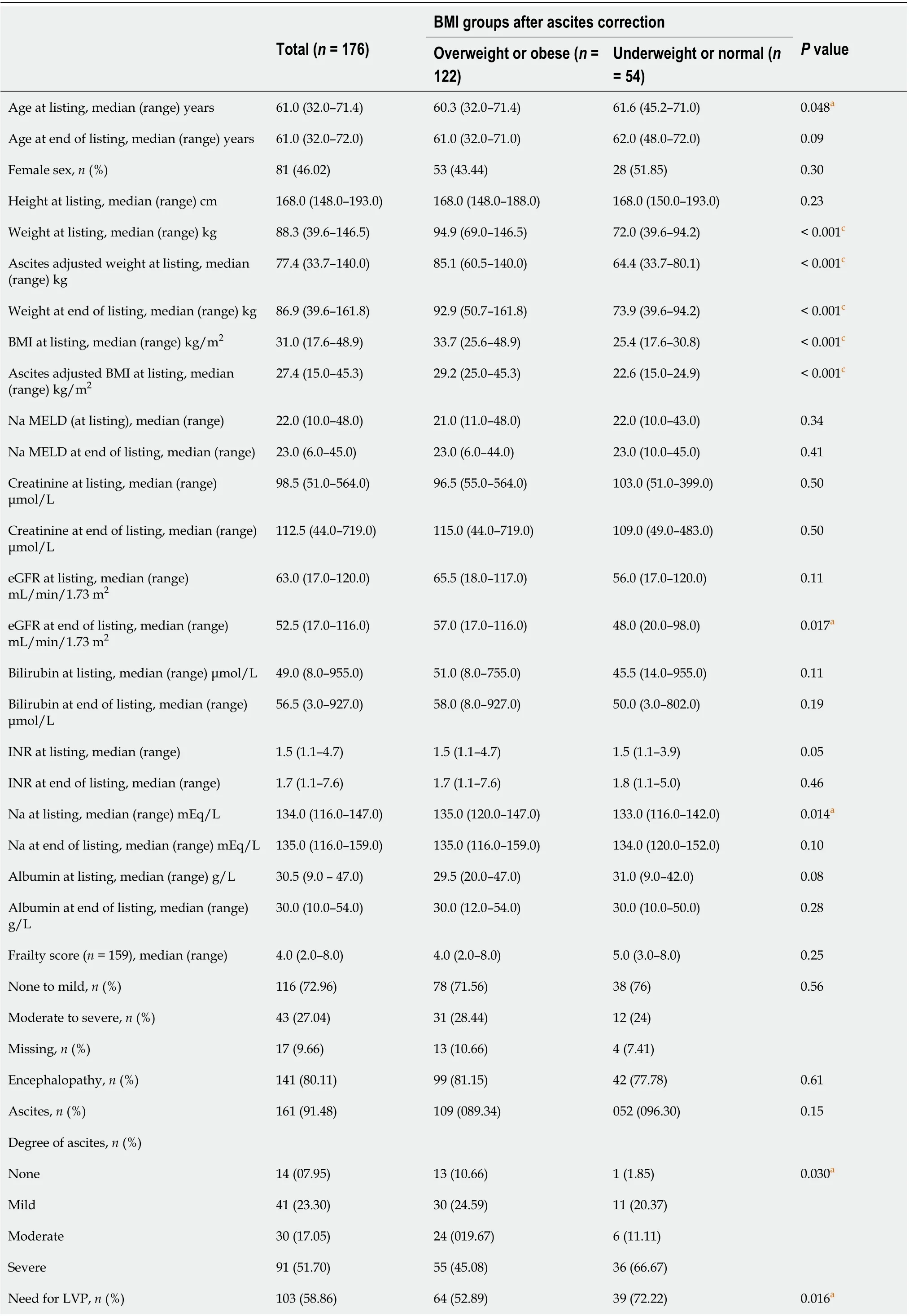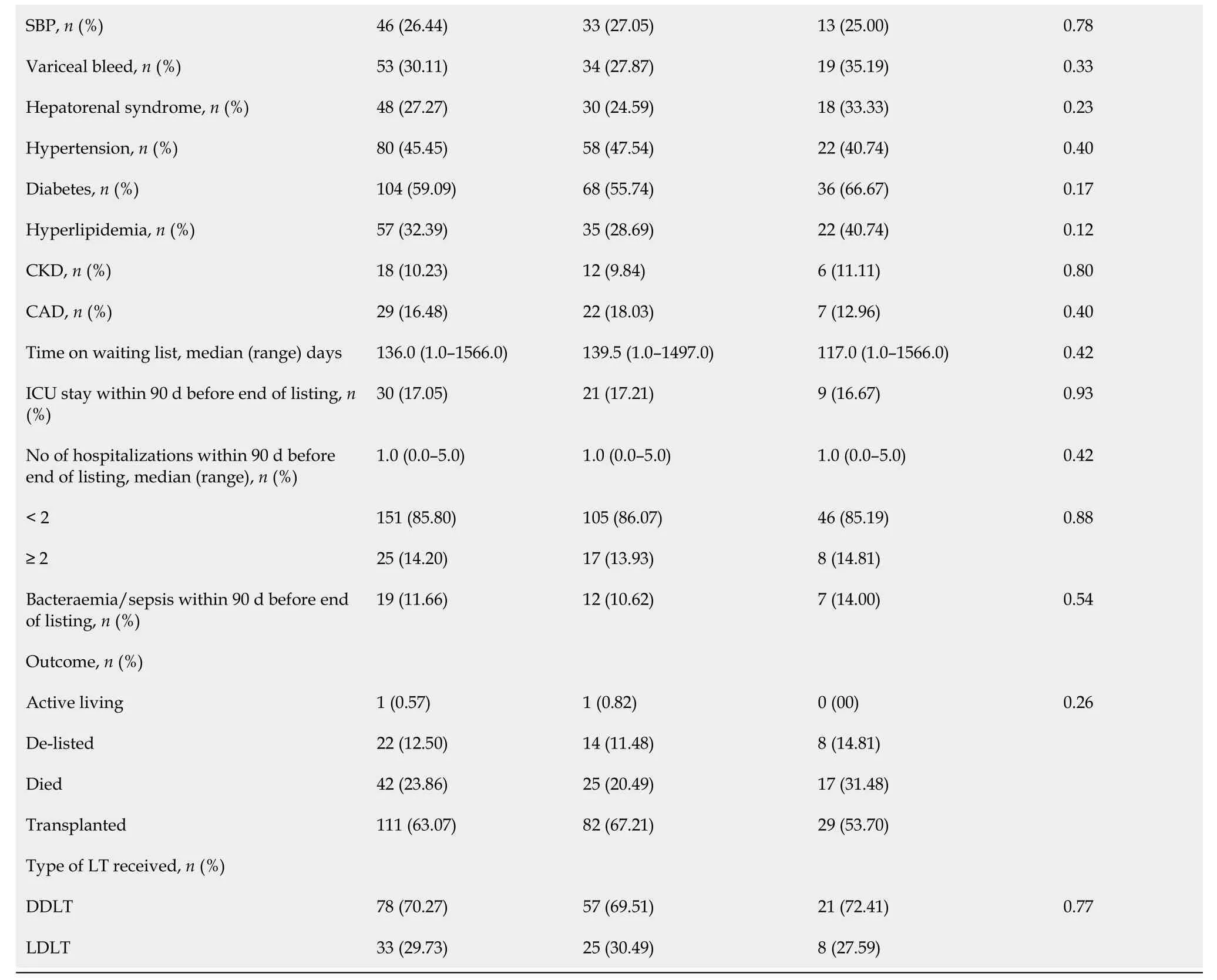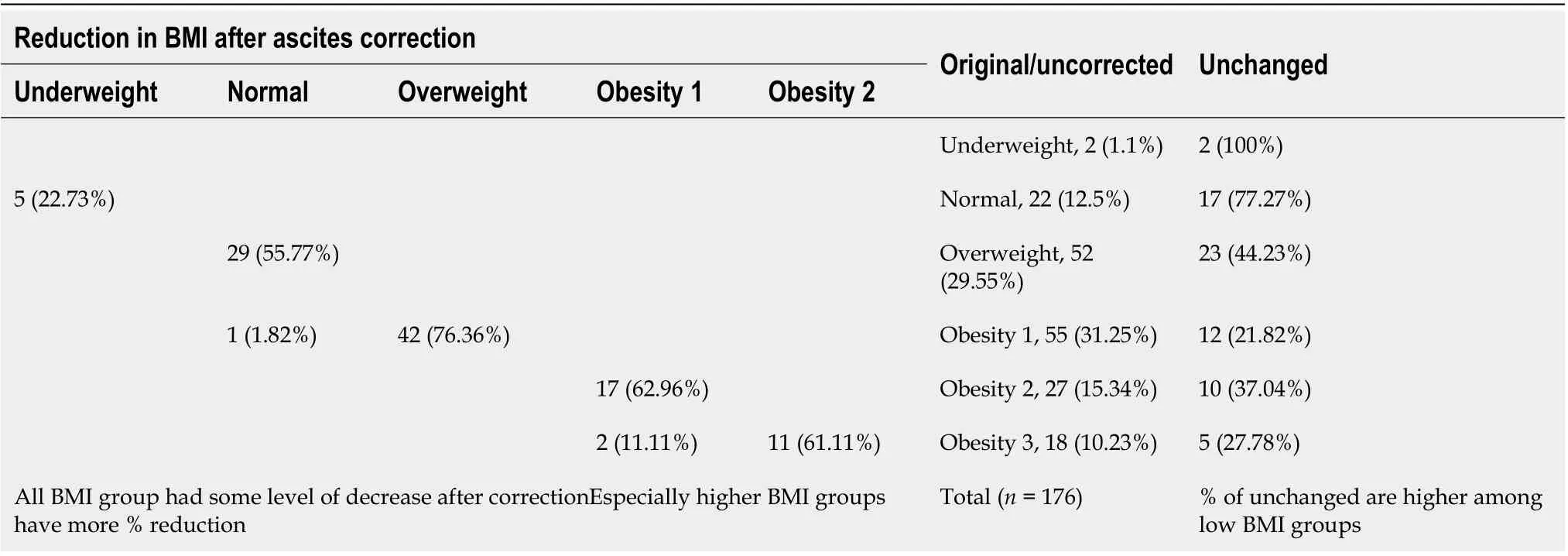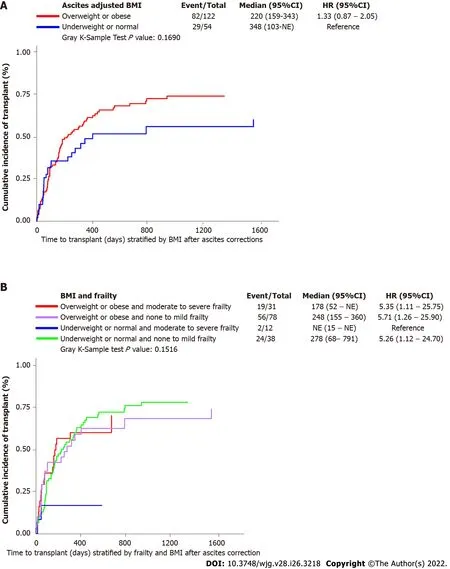Divergent trajectories of lean vs obese non-alcoholic steatohepatitis patients from listing to post-transplant:A retrospective cohort study
2022-07-30QaziArisarFAUchilaChenYangChenSYKarnamRSAzhieXuGalvinSelznerLillyBhat
Qazi-Arisar FA, Uchila R, Chen C, Yang C, Chen SY, Karnam RS, Azhie A, Xu W, Galvin Z, Selzner N, Lilly L, Bhat M
Abstract
Key Words: Outcomes; Frailty; Waitlist; Liver transplant; Survival
lNTRODUCTlON
Non-alcoholic steatohepatitis (NASH) cirrhosis is currently the second most common indication for liver transplantation (LT) and is on track to become the leading indication by 2030 in the United States[1,2].The ability to cure hepatitis C with antivirals and the twin epidemics of diabetes and obesity have fueled the rise of NASH as an indication for LT worldwide.
NASH patients are often older at presentation and have some or all the components of metabolic syndrome such as diabetes, hypertension, dyslipidemia, and obesity. Non-alcoholic fatty liver disease(NAFLD) and NASH have also been described in the absence of obesity[3]. About 25% of all NAFLD patients exhibit this lean phenotype[4]. However, the role of body mass index (BMI) on outcomes of NASH cirrhosis has been conflicting. Several studies have disproved the perception of NAFLD being a'milder' condition in lean individuals. In fact, lean patients with NASH have been shown to have more severe liver disease, more advanced fibrosis, shorter waitlist survival, and poorer post-transplant graft and patient survival[5-8].
However, these retrospective studies have been limited by their ability to accurately interpret BMI and the paucity of specific details regarding waitlist and post-transplant outcomes such as cardiometabolic disease, recurrent NASH, and graft fibrosis. Previous attempts to correct BMI for ascites have been shown to move at least 20% of patients to a lower BMI group[9]. Therefore, our study's objective is to compare the longitudinal trajectories of patients with leanvsobese NASH cirrhosis, from listing up to post-transplant, having adjusted their BMI for ascites.
MATERlALS AND METHODS
The study was approved by the Research Ethics Board of the University Health Network (Toronto,Canada).
Patients
This was a single-centre retrospective study of all NASH cirrhosis patients listed for LT between November 12, 2012, and May 31, 2019, in the Multi-Organ Transplant Program at the University Health Network in Toronto, Canada. The study's start date was decided as November 13, 2012, as our program transitioned to the model for end stage liver disease (MELD)-Na system for listing on that day. All patients were followed until May 31, 2020, yielding a minimum follow-up of 1 year. In our program,NASH cirrhosis was diagnosed either based on findings of significant steatosis on histopathology (pretransplant liver biopsy or explant pathology), or the presence of risk factors (diabetes, obesity, and metabolic syndrome) in the absence of significant alcohol consumption and evidence of other etiology on serology or histopathology.
We excluded candidates listed for hepatocellular carcinoma with exception points, all other candidates listed with exception points, patients with fulminant liver failure, NASH concomitant with a secondary etiology of chronic liver disease (such as alcohol, viral, autoimmune hepatitis, or cryptogenic cirrhosis), multiorgan transplants and those relisted for transplantation.
Data collected from the database on each recipient at the time of listing included age, gender, height,weight, BMI, Na MELD, Creatinine, estimated glomerular filtration rate (eGFR), biochemical parameters(bilirubin, albumin, international normalized ratio), frailty using clinical frailty scale, complications of cirrhosis including the severity of ascites and associated comorbidities were collected. The severity of ascites (mild, moderate, or severe) is graded according to what was recorded in the patient's clinical notes as determined either by physical or more often by radiological examination. Duration on the waitlist, intensive care unit (ICU) stay, sepsis, outcomes on the waitlist, reasons for delisting, and cause of death were also collected. Post-transplant data includes the type of transplant, re-hospitalization within 90 d, recurrence of NAFLD and NASH, time to recurrent NAFLD or NASH, metabolic,cardiovascular, and biliary complications, BMI at 1 and 5 years, patient, and graft survival details.
The above data was collected from the Organ Transplant Tracking Registry software, an internal transplant database linked to the electronic medical record of all patients evaluated at the University Health Network.
Our primary outcomes included patient and graft survival at 90 d, 1- 3- and 5 years.
Dry-weight BMI or adjusted BMI
The adjusted BMI was calculated by evaluating the patient's dry weight, which is estimated by postparacentesis body weight, or weight recorded before fluid retention if available, or by subtracting a percentage of weight based upon the severity of ascites (mild 5%; moderate 10%; severe 15%) as performed in several studies. The dry-weight BMI or adjusted BMI was then calculated by dividing the patient’s estimated dry weight (kg) by the square of the patient’s height (m) as performed in several studies[10,11]. We categorized the variable of calculated adjusted BMI at listing into two groups: Group 1 comprising of overweight (BMI ≥ 25 and < 30 kg/m2) or obese group (BMI ≥ 30 kg/m2) and Group 2 comprising of underweight (< 18.5 kg/m2) or normal (≥ 18.5 and < 25 kg/m2) BMI group.
Adjusted BMI was determined for all the listed patients. The cohort of patients was analyzed according to their weight category.
Statistical analysis
A two-sided test with an overall sample size of 153 subjects (51 in the underweight or normal group,and 102 in the overweight or obese group) achieved 80% power at a 0.05 significance level when the estimated hazard ratio (HR) for the overall survival was 0.5 with the null hypothesis of HR = 1. To account for drop-offs, final sample size was increased to 54 and 122. These results assume that the HR was constant throughout the study and that Cox proportional hazards (PH) regression was used to analyze the data.
Descriptive statistics were performed for demographic and clinical variables. Counts and proportions were calculated for categorical variables and the differences between patients with leanvsobese NASH were compared using the Chi-squared test or Fisher’s exact test. Mean ± SD and median (range) were calculated for continuous variables and the differences between the two groups were compared using two-sample t-tests or Wilcoxon tests, depending on the distribution of the data.
Cumulative incidence of transplant by leanvsobese NASH was plotted and group differences were compared using Gray k-sample test and Fine-Gray Competing risk models. Kaplan-Meier plots for waitlist survival and post-transplant survival were also plotted and differences between patients with lean and obese NASH were compared using log-rank tests and Cox PH models. Complete-case analyses were performed on observations with complete sets of data while the data for observations that has one or more missing values were removed.
Sample size was calculated using PASS (Power Analysis and Sample Size Software) 2021. (NCSS,LLC. Kaysville, Utah, United States, ncss.com/software/pass). SAS 9.4 (SAS Institute, Cary NC) was used to perform statistical analyses. Statistical significance was defined as aPvalue of ≤ 0.05.
RESULTS
Patient characteristics
Out of 265 patients listed for NASH cirrhosis, 176 met the eligibility criteria. The median age was 61(32-71.4) years; 46% were females. A total of 111 patients underwent LT, 78 deceased donor LT (DDLT),and 33 living donor LT (LDLT). Table 1 describes the pre-LT clinical and laboratory variables.
Impact of ascites on BMI
Correcting for ascites volume resulted in patients moving into a lower BMI classification among all groups except the underweight group (BMI < 18 kg/m2). The change was larger among patients in the higher BMI groups with 72.2%, 62.9%, and 78.1% of patients moved to a lower BMI group from Obesity classes 3, 2, and 1, respectively as shown in Table 2.
Waitlist parameters and outcomes
Patients in lean NASH group were elderly at time of listing (median age 61.6 yearsvs60.3 years,P=0.048), had worse renal functions at end of listing (median eGFR 48 mL/min/1.73 m2vs57 mL/min/1.73 m2,P= 0.017), carried more severe ascites (66.6%vs45%,P= 0.03) and were more paracentesis dependent (72.2%vs52.9%,P= 0.016). Other characteristics such as sex, clinical frailty scale, and frequency of complications were similar between the two groups.
Patients in the overweight/obese group spent a median of 139.5 d on the waitlist which was not dissimilar to the 117 d spent by their counterparts in the lean group. Waitlist events such as episodes of sepsis and ICU stay were similar in the two groups. With regards to waitlist outcomes, a similar number of patients were de-listed or transplanted in both groups. More patients belonging to the lean NASH group compared to the obese group died (31.5%vs20.5%,P= 0.26); however, the difference was not significant. Time to death or delisting was similar in both obese and lean groups (HR: 0.83; 95%CI:0.46-1.50,P= 0.53). However, when sub-grouped based on BMI and frailty, patients with obese NASH and none/mild frailty had better survival than lean NASH with moderate to severe frailty (HR: 0.12;95%CI: 0.05-0.29,P< 0.0001) (Figure 1).
With regards to transplant data, a comparable number of patients underwent DDLT and LDLT in both obese and lean groups (DDLT: 69.5% in overweight/obese group and 72.4% in the lean group;P=0.77). The cumulative incidence of transplant was equal in both groups (HR: 1.33; 95%CI: 0.87-2.05,P=0.16). However, obese NASH patients with none/mild frailty had a significantly better instantaneous rate of transplant than lean NASH with moderate to severe frailty (HR: 5.71; 95%CI: 1.26-25.9,P= 0.02)(Figure 2). The Median cold ischemia time in obese patients undergoing DDLT was significantly longer than that of lean patients (465 minvs330.5 min,P= 0.024).
Post-transplant outcomes
Compared to listing, the obese group had a significant reduction in BMI 1 year post-transplant (β = -2.08, SE = 0.87,P= 0.006). At 5-year post-transplant, the overweight or obese group's BMI returned to the same level as listing time (β = 1.80, SE = 1.54,P= 0.52). No change in BMI was observed in the underweight or normal group (overallP= 0.3) (Figure 3). There was no difference in post-transplant parameters such as 90-d rehospitalization, biliary complications or recurrence of NASH in leanvsobese groups. However, renal function was significantly better in lean NASH patients at 5 years (median creatinine 111 μmol/Lvs153.5 μmol/L,P= 0.019) (Table 3).
The graft loss within 90 d post-transplant (1.2%vs13.8%,P= 0.032) and death following transplant(2.4%vs17.2%,P= 0.029) were significantly higher in lean patients compared to obese patients. The 1- 3-and 5-year graft survivals were significantly worse for lean patients 98.6%, 96% and 85%vs78.6%, 77.3%and 41.7% respectively, allP< 0.05) (Table 3). There was a trend toward worse 1- 3- and 5-year patient survival (98.7%, 96% and 90%vs89.7%, 81.8% and 58.3%;P= 0.06, 0.07 and 0.07 respectively). The two groups were analysed to compare patient survival using Kaplan Meier Survival Plots and Cox PH models, which noted a statistically significant difference in overall survival between the two groups(HR: 0.17; 95%CI: 0.03-0.86,P= 0.0142). The instantaneous rate of death in the overweight/obese group was 83% lower than those in the underweight/normal weight group (Figure 4).
DlSCUSSlON
Our study highlights the paradoxical impact of pretransplant BMI on the survival of NASH patients post-liver transplant, with lean NASH patients demonstrating inferior 90-d, 1- 3- and 5-year graft survival, and overall patient survival.
Lean NAFLD prevalence varies from 12% to 20% depending on the population. The presence of comorbid conditions such as components of metabolic syndrome along with older age increases the morbidity and mortality of NASH cirrhotic patients. However, it is unclear if the same applies to lean NASH. The prevalence of metabolic syndrome is less common in lean NAFLD patients as compared toobese[4,12-14]. A long-term follow-up study showed that biopsy-proven lean NAFLD patients are more likely to develop severe liver disease (F3/F4) than overweight patients[5]. Literature is scant about the outcomes of lean NASH while on the waiting list for LT. A study comprising of 1090 patients revealed shorter cumulative survival in lean NAFLD compared to non-lean NAFLD (log-rank test = 5.6;P< 0.02)[6] In a recent study, morbid obesity and diabetes were related to an increased risk of drop out of NASH patients from the waiting list[15].

Table 1 Pre-liver transplant clinical and laboratory variables

aP < 0.05.cP < 0.001.BMI: Body mass index; CAD: Coronary artery disease; CKD: Chronic kidney disease; DDLT: Deceased donor liver transplant; eGFR: Estimated glomerular filtration rate; ICU: Intensive care unit; INR: International normalized ratio; LT: Liver transplant; LDLT: Living donor liver transplant; LVP: Large volume paracentesis; MELD: Model for end stage liver disease; Na: Sodium; SBP: Spontaneous bacterial peritonitis.
Frailty, a common complication of cirrhosis, is seen more frequently in NASH cirrhosis patients as compared to other etiologies such as alcoholic liver disease[16]. Frailty has previously been shown to determine a patient’s overall health, the number of hospitalizations, length of hospital stay, delisting,and waitlist mortality[17-21]. especially in patients older than 65 years of age[22] independent of portosystemic encephalopathy or ascites[23]. However, the impact of frailty in the NASH cohort was not assessed. In a multicentre study, frailty was associated with a 2-fold higher risk of wait-list mortality among nonobese/class 1 obese patients, while more than 3-fold higher risk of wait-list mortality among class 2 or greater obese liver transplant candidates[24]. However, NASH comprised only 17.5% of their patient population, while BMI was not corrected for ascites which was present in 37.1% of their patients.In a retrospective analysis, a higher frailty score was associated with an increased risk of delisting in NASH patients (HR: 1.46; 95%CI: 1.06-2.03,P= 0.02)[16]. In our study, lean NASH patients with frailty had poor survival (HR: 0.12; 95%CI: 0.05-0.29,P< 0.0001) with lower instantaneous rate of transplant(HR: 5.71; 95%CI: 1.26-25.9,P= 0.02). Therefore, the convergence of frailty with lean NASH led to significantly worse outcomes on the waitlist as well as in the early period post-transplant.
Though lean NAFLD is considered to be benign, the dysfunctional adipose tissue, in particular,visceral adiposity is related with increase cardiometabolic risk in lean NAFLD. Further, alterations inTM6SF2, a gene conferring susceptibility to NASH and fibrosis, are shown to be increased in lean NAFLD than obese NAFLD patients. However, there is a paucity of data on post-transplant outcomes in lean patients specifically[25]. In the post-transplant setting, a pivotal study looking at the patients on the UNOS database revealed that both short- and long-term survivals were low in patients who were morbidly obese before transplantation, owing to adverse cardiovascular events[26]. However, none of the patients in this study belonged to the NASH group. On the contrary, obesity was noted to paradoxically favour the NASH patients compared to their non-NASH counterparts. A recent study found that lean patients have both poorer graft and patient survival than their obese counterparts[7]. However,they did not adjust the BMI for ascites, whereas elevated BMI might have reflected fluid overload instead of true obesity. There is still much that is not known or understood, and hence it is challenging to explain the underlying molecular mechanisms linking lean NASH with worse outcomes post LT.Nonetheless, our study also confirms the enigmatic effect of obesity in the NASH subset. This study also highlighted the importance of correcting BMI for ascites. Despite correcting BMI for ascites, 69% of NASH patients belong to the overweight/obese group.

Table 2 Percentage of patients who changed body mass index groups after ascites correction
NASH has been associated with metabolic syndrome-related complications such as cardiovascular disease and chronic kidney disease (CKD)[27]. Post-transplant the risk of metabolic complications increases further owing to the immunosuppressive medications. Furthermore, calcineurin inhibitors carry direct nephrotoxic effects. In general, obese NAFLD patients appear to have a higher risk of developing CKD than non-obese[28]. In post-LT patients, obesity has been identified as a risk for postoperative severe acute kidney injury[29] as well as renal disease progression needing a kidney transplant after LT[30]. We further augmented this data by showing that median creatinine in our obese patients was significantly higher than in lean patients at 5 years (153.5 μmol/Lvs111 μmol/L,P=0.019). The incidence of diabetes and hypertension were numerically higher in the obese group at 1 and 5 years, however, this difference was statistically insignificant. Further, the incidence of cardiovascular events was also not significantly different among the two groups. Further expansion of follow-up to 10 years might show a statistically meaningful difference. However, this analysis was not possible in the current study. Given the selection criteria with the start of the study from November 2012, none of the patients has achieved the 10-year benchmark yet.
This study has been limited by its retrospective design, smaller sample size, and lack of a comparison group from a non-NASH subset. We also acknowledge the limitation of missing data given the retrospective design, transfer of care to other local centres post-transplant, and a limited number of patients achieving the 5-year benchmark. The results of this study should be interpreted cautiously as it does not suggest the listing of all morbidly obese NASH cirrhotic patients for liver transplant.Nonetheless, under current practice, outcomes of carefully selected NASH patients with higher BMI are better than their lean counterparts. This conundrum could have been explained by improvement in patient selection protocols, post-transplant critical care support, and immunosuppressive treatment.Future larger studies would be required to validate the generalizability of our findings. Moreover, there is need of identifying the factors such as genetic variants, and body fat distribution/visceral adiposity,which can play role in this paradox.
CONCLUSlON
Lean NASH is associated with adverse outcomes on the waiting list as well as early post-transplant, inconjunction with often comorbid frailty. Our study emphasizes the need to actively support the nutritional and physical functional status of lean NASH patients on the waiting list. Post-transplant, all NASH patients should have active lifestyle counselling regarding a healthy diet and regular exercise to improve long-term cardiometabolic outcomes.

Table 3 Post transplant outcomes

Figure 1 Kaplan-Meier-overall survival: Time to delisting or death on waitlist. A: Ascites adjusted body mass index (BMI) groups (non-transplanted patients only); B: Ascites adjusted BMI and frailty (full cohort); C: Ascites adjusted BMI and frailty (non-transplanted patients only). HR: Hazard ratio; BMI: Body mass index.

Figure 2 Competing risk analysis for time to transplant. A: Ascites adjusted body mass index (BMI) groups; B: Ascites adjusted BMI and frailty. HR:Hazard ratio; BMI: Body mass index.

Figure 3 Change in body mass index from time of listing to post liver transplant at 1 and 5 yr. BMI: Body mass index.

Figure 4 Kaplan-Meier-overall survival: Time to death post liver transplant stratified by ascites adjusted body mass index groups. Lower panel shows the 1- and 5-yr survival estimates. HR: Hazard ratio; BMI: Body mass index.
ARTlCLE HlGHLlGHTS

FOOTNOTES
Author contributions:Qazi-Arisar FA and Uchila R given their equal contribution in the manuscript; Bhat M was the guarantor and designed the study; Qazi-Arisar FA, Uchila R, Chen C, Yang C, Chen SY, Karnam RS and Azhie A participated in the acquisition, analysis, and interpretation of the data, and drafted the initial manuscript; Qazi-Arisar FA, Xu W, Galvin Z, Selzner N, Lilly L and Bhat M revised the article critically for important intellectual content.
lnstitutional review board statement:The study was reviewed and approved by the Research Ethics board of the University Health Network (Toronto, Canada).
lnformed consent statement: Given retrospective nature of study from chart review, written informed consent was not required.
Conflict-of-interest statement:Dr. Bhat reports other from Novo Nordisk, other from Ipsen, grants from Paladin,grants from Natera, grants from Oncoustics, grants from MedoAI, grants from Lallemand, personal fees from Novartis, personal fees from Lupin, outside the submitted work.
Data sharing statement:No additional data are available.
STROBE statement:The authors have read the STROBE Statement—checklist of items, and the manuscript was prepared and revised according to the STROBE Statement—checklist of items.
Open-Access:This article is an open-access article that was selected by an in-house editor and fully peer-reviewed by external reviewers. It is distributed in accordance with the Creative Commons Attribution NonCommercial (CC BYNC 4.0) license, which permits others to distribute, remix, adapt, build upon this work non-commercially, and license their derivative works on different terms, provided the original work is properly cited and the use is noncommercial. See: https://creativecommons.org/Licenses/by-nc/4.0/
Country/Territory of origin:Canada
ORClD number:Mamatha Bhat 0000-0003-1960-8449.
Corresponding Author's Membership in Professional Societies:American Association for the Study of Liver Diseases.
S-Editor:Fan JR
L-Editor:A
P-Editor:Yu HG
杂志排行
World Journal of Gastroenterology的其它文章
- Intestinal virome: An important research direction for alcoholic and nonalcoholic liver diseases
- Intestinal inflammation and the microbiota: Beyond diversity
- Epidemiological and clinical aspects of hepatitis B virus infection in Italy over the last 50 years
- Alterations of autophagic and innate immune responses by the Crohn’s disease-associated ATG16L1 mutation
- Advances in the imaging of gastroenteropancreatic neuroendocrine neoplasms
- Intracellular alpha-fetoprotein mitigates hepatocyte apoptosis and necroptosis by inhibiting endoplasmic reticulum stress
